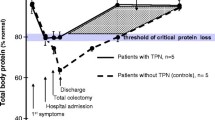Abstract
Objective
To compare the initial (D7) calorie intake and tolerability of two early enteral nutrition protocols in which the optimal flow rate was introduced either immediately or gradually.
Design
Open, prospective, randomized study.
Setting
Two medical-surgical intensive care units.
Patients
One hundred consecutive intubated and mechanically ventilated patients.
Interventions
Early enteral nutrition was started within 24 h following intubation, and the optimal flow rate (25 Kcal/kg day−1) was either introduced immediately or reached in increments. Flow rate of the nutritional solution was adapted to the residual gastric volume, measured every 8 h, and the use of prokinetic agents was encouraged. Vomiting, regurgitation, colectasia, and suspected aspiration were defined as serious adverse events requiring withdrawal of enteral nutrition.
Measurements and results
When introduced immediately at optimal flow rate, early enteral nutrition led to a significant improvement in actual calorie supply (p < 0.0001). Although high residual gastric volume (> 300 ml) was more frequent when optimal flow rate was introduced immediately ( p = 0.04), frequency of serious adverse events necessitating withdrawal of enteral nutrition was similar in the two groups (p = 0.64).
Conclusions
When residual gastric volume is measured regularly and prokinetic agents are used, enteral nutrition can be started early and be introduced at optimal dose regimen, thereby providing better calorie intake. Serious adverse events required early enteral nutrition withdrawal in only 15 patients, with no difference in frequency between the groups.

Similar content being viewed by others
References
Heyland DK, Dhaliwal R, Drover JW, Gramlich L, Dobek P, The Canadian Critical Care Clinical Practice Guidelines Committee (2003) Canadian clinical practice guidelines committee for nutrition support in mechanically ventilated critically ill adult patients. JPEN 27:355–373
Jolliet P, Pichard C, Biolo G, Chioléro R, Grimble G, Leverve X, Nitenberg G, Novak I, Planas M, Preiser JC, Roth E, Schols AM, Wernerman J (1998) Enteral nutrition in intensive care patients: a practical approach. Intensive Care Med 24:848–859
Marik PE, Zaloga GP (2001) Early enteral nutrition in acutely ill patients: a systematic review. Crit Care Med 29:2264–2270
De Jonghe B, Appere-De-Vechi C, Fournier M, Tran B, Merrer J, Melchior JC, Outin H (2001) A prospective survey of nutritional support practices in intensive care unit patients: What is prescribed? What is delivered? Crit Care Med 29:8–12
Mentec H, Dupont H, Bocchetti M, Cani P, Ponche F, Bleichner G (2001) Upper digestive intolerance during enteral nutrition in critically ill patients: frequency, risk factors, and complications. Crit Care Med 29:1955–1961
Ibrahim EH, Mehringer L, Prentice D, Sherman G, Schaiff R, Fraser V, Kollef MH (2002) Early versus late enteeral feeding of mechanically ventilated patients: results of a clinical trial. JPEN 26:174–181
Pinilla JC, Samphire J, Arnold C, Liu L, Thiessen B (2001) Comparaison of gastrointestinal tolerance to two enteral feeding protocols in critically ill patients: a prospective, randomized controlled trial. JPEN 25:81–86
Heyland D, Cook DJ, Winder B, Brylowski L, Van demark H, Guyatt G (1995) Enteral nutrition in the critically ill patient: a prospective survey. Crit Care Med 23:1055–1060
McClave SA, Sexton LK, Spain DA, Adams JL, Owens NA, Sullins MB, Blandford BS, Snider HL (1999) Enteral tube feeding in the intensive care unit: factors impending adequate delivery. Crit Care Med 27:1252–1256
Le Gall JR, Lemeshow S, Saulnier F (1993) A new simplified acute physiology score (SAPS II) based on an European north American multicenter study. J Am Med Assoc 270:2957–2963
Reignier J, Bensaid S, Perrin-Gachdoat D, Burdin M, Boiteau R, Tenaillon A (2002) Erythromycin and early enteral nutrition in mechanically ventilated patients. Crit Care Med 30:1237–1241
Adam S, Batson S (1997) A study of problems associated with the delivery of enteral feed in critically ill patients in five ICUs in the UK. Intensive Care Med 23:261–266
McClave SA, Lukan LK, Stefater JA, Lowen CC, Looney SW, Matheson PJ, Gleeson K, Spain DA (2005) Poor validity of residual volumes as a marker for risk of aspiration in critically ill patients. Crit Care Med 33:324–330
Van Der Spoel JI, Schultz MJ, Van Der Voort PHJ, De Jonghe E (2006) Influence of severity of illness, medication and selective decontamination on defecation. Intensive Care Med 32:875–880
Acknowledgements
In addition to the co-authors of this article, the following investigators participated in the study: O. Baudin; S. Calvat (Angoulême); and P. Vignon (Limoges).
Author information
Authors and Affiliations
Corresponding author
Rights and permissions
About this article
Cite this article
Desachy, A., Clavel, M., Vuagnat, A. et al. Initial efficacy and tolerability of early enteral nutrition with immediate or gradual introduction in intubated patients . Intensive Care Med 34, 1054–1059 (2008). https://doi.org/10.1007/s00134-007-0983-6
Received:
Accepted:
Published:
Issue Date:
DOI: https://doi.org/10.1007/s00134-007-0983-6



